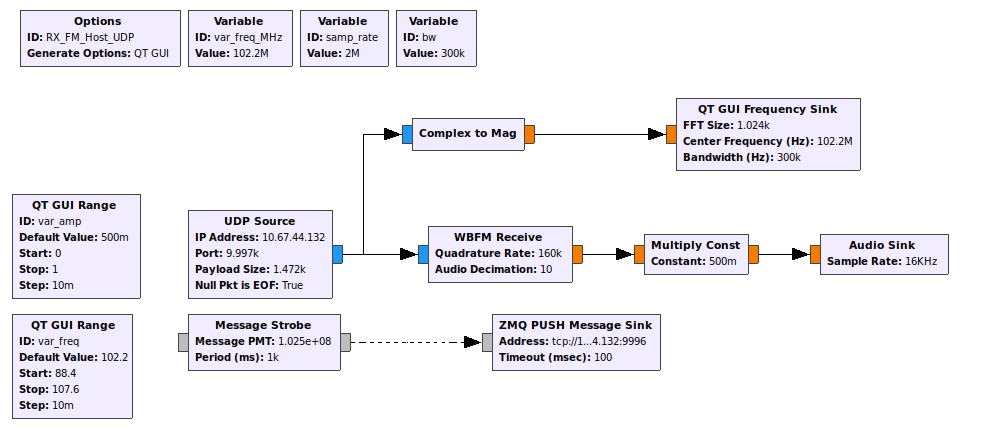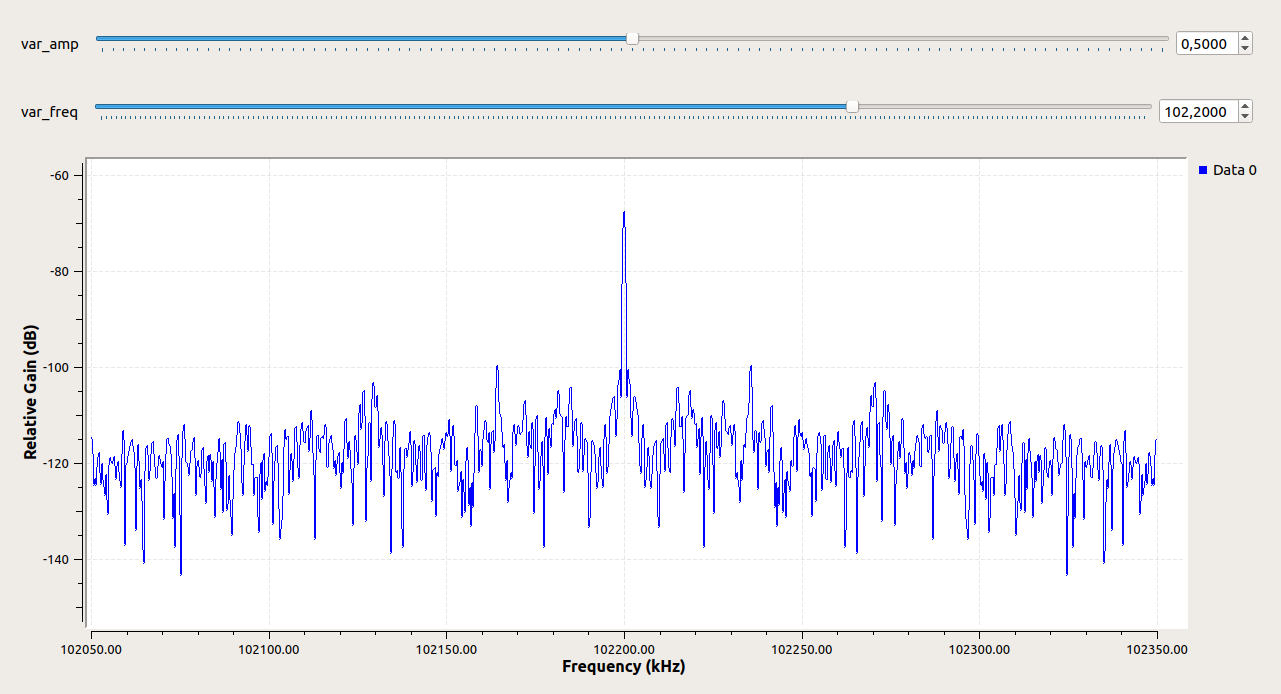E310 FM Receiver
| Beginner Tutorials
Introducing GNU Radio Flowgraph Fundamentals
Creating and Modifying Python Blocks DSP Blocks
SDR Hardware |
This tutorial describes how to receive broadcast commercial radio stations transmitting Frequency Modulated (FM) signals using the Ettus Research E310.
USRP (E310) Setup Guide
This page provides step-by-step instructions to configure a USRP E310 for:
- Receiving signals with a Python script
- Remote control via SSH
- Using GNU Radio on a host machine
Hardware Connection
- Plug the antenna into the RX2-A port on the USRP. The RX2-A port is dedicated to receive (RX) operations.
- Turn on the USRP and ensure it has a stable power supply.
Initialization of the USRP
see dedicated page
Determine the USRP’s IP Address
On your host machine (connected to the same network):
sudo snap install nmap # Install nmap if not already present
nmap -sn 10.0.0.0/24 # Scan the local subnet
- This finds the DHCP‑assigned IP of the USRP (e.g., 110.0.0.100).
Assign a Static IP Address
To simplify SSH access, give the USRP a fixed IP.
Create the static_ip.sh Script
SSH into the USRP (using the DHCP IP) and run:
nano static_ip.sh
Paste the following:
#!/bin/sh
# 1. Flush existing IP addresses
ip addr flush dev eth0
# 2. Assign static IP and netmask
ip addr add 10.0.0.200/24 dev eth0
# 3. Bring the interface up
ip link set eth0 up
# 4. Add default gateway
ip route add default via 10.0.0.1
- Each step configures the Ethernet interface (eth0) for static addressing.
Run the Script
bash static_ip.sh
- The IP remains active until the next reboot.
SSH Connection
On the host:
ssh root@10.0.0.200
- You now have remote shell access to the USRP.
Mount USRP Filesystem via SSHFS
To edit USRP files locally:
sshfs root@10.0.0.200:/ ~/remote_usrp
- Mounts the USRP’s root directory at `~/remote_usrp` on the host.
Configure Geany IDE
To simplify the workflow, we will use Geany, a lightweight IDE, on the host machine to:
- Edit files located on the USRP (via SSHFS)
- Launch scripts remotely on the USRP (via SSH)
- Centralize all development and execution within one interface
- This allows you to work entirely from the host, avoiding the need to manually SSH into the USRP or use a separate editor.
Open Build Commands
In Geany, go to Build → Set Build Commands.
Create the start_usrp_script.sh Script
Before applying the static IP, prepare the Geany startup helper on the USRP:
nano /home/root/start_script_geany.sh
Paste the following:
#!/bin/sh
cleanup() {
echo '[INFO] Stop requested'
pkill -f RX_FM_USRP_UDP.py
exit 0
}
trap cleanup INT TERM
python3 /home/root/RX_FM_USRP_UDP.py
- This script installs a cleanup handler that intercepts interrupt or termination signals, cleanly kills the FM‑UDP Python process, and exits. When Geany’s “Execute” command runs this script remotely, RX_FM_USRP_UDP.py is launched and properly managed.
Update the Build Commands
In "Independent Commands", to the right of "Run Remote", add:
scp "%f" root@10.0.0.200:/tmp/ && ssh root@10.0.0.200 'python3 /tmp/"%f"'
- This single command performs two actions back-to-back: first, it securely transfers the file you’re editing to the USRP’s temporary directory over SSH; then, once that transfer completes successfully, it opens an SSH session on the USRP and immediately invokes Python 3 to run the uploaded file from its temporary location. In other words, it bundles “copy the script over” and “execute it remotely” into one seamless operation.
In "Execute commands", to the right of "Execute", add:
ssh -t root@10.0.0.200 "bash -i -c '/home/root/start_script_geany.sh'"
USRP/Host Codes and flowgraphs
All operations are performed in a networked setup where a host PC (IP address 10.0.0.100) handles control messaging and UDP reception, and the USRP E310 (IP address 10.0.0.200) runs the GNURadio flowgraph and streams data.
USRP Code
This script is written in Python to be more easily edited and executed remotely via Geany on the host machine, providing flexibility and rapid iteration.
#!/usr/bin/env python3 # Corrected for execution on host
# -*- coding: utf-8 -*-
import time
import signal
import sys
from gnuradio import gr, blocks, analog, filter, uhd, zeromq
from gnuradio.filter import firdes
from message_to_freq import message_to_freq # Custom block: maps incoming ZMQ messages to frequency updates
from message_to_gain import message_to_gain # Custom block: maps incoming ZMQ messages to gain updates
class RX_FM_USRP_UDP(gr.top_block):
def __init__(self):
gr.top_block.__init__(self, "Rx FM USRP UDP Headless")
##################################################
# Variables
##################################################
self.samp_rate = 2e6 # Sample rate for USRP
self.gain = 15 # Initial gain (dB)
self.freq = 102.5e6 # Center frequency (Hz)
self.freq_cos = 300e3 # Offset for cosine mixing (Hz)
self.bw = 200e3 # RF bandwidth (Hz)
##################################################
# USRP Source
##################################################
self.uhd_source = uhd.usrp_source(
",".join(('', '')), # Empty args: will use default device
uhd.stream_args(cpu_format="fc32", channels=[0]),
)
self.uhd_source.set_samp_rate(self.samp_rate)
self.uhd_source.set_center_freq(self.freq, 0)
self.uhd_source.set_gain(self.gain, 0)
self.uhd_source.set_antenna("RX2", 0)
self.uhd_source.set_bandwidth(self.bw, 0)
##################################################
# Signal Processing Chain
##################################################
# Generate a cosine wave for mixing
self.sig_source = analog.sig_source_c(
self.samp_rate, analog.GR_COS_WAVE, self.freq_cos, 1, 0
)
# Multiply RF signal with cosine to shift frequency
self.mult = blocks.multiply_vcc(1)
# Low-pass filter to isolate FM bandwidth
self.lowpass = filter.fir_filter_ccf(
decimation=10,
taps=firdes.low_pass(1, self.samp_rate, 90e3, 5e3, firdes.WIN_HAMMING)
)
# Rational resampler to adjust sample rate for UDP sink
self.resampler = filter.rational_resampler_ccc(
interpolation=12, decimation=15
)
# Send complex baseband samples over UDP to host
self.udp_sink = blocks.udp_sink(
gr.sizeof_gr_complex, '10.0.0.100', 9997, 1472, True
)
##################################################
# ZMQ Control: Frequency Updates
##################################################
self.zmq_pull_freq = zeromq.pull_msg_source(
'tcp://10.0.0.100:9996', 100
)
self.msg_freq_handler = message_to_freq(self.set_freq)
self.msg_connect(
(self.zmq_pull_freq, 'out'),
(self.msg_freq_handler, 'in')
)
##################################################
# ZMQ Control: Gain Updates
##################################################
self.zmq_pull_gain = zeromq.pull_msg_source(
'tcp://10.0.0.100:9995', 100
)
self.msg_gain_handler = message_to_gain(self.set_gain)
self.msg_connect(
(self.zmq_pull_gain, 'out'),
(self.msg_gain_handler, 'in')
)
##################################################
# Block Connections
##################################################
self.connect((self.uhd_source, 0), (self.mult, 0))
self.connect((self.sig_source, 0), (self.mult, 1))
self.connect((self.mult, 0), (self.lowpass, 0))
self.connect((self.lowpass, 0), (self.resampler, 0))
self.connect((self.resampler, 0), (self.udp_sink, 0))
def set_freq(self, freq):
"""Update center frequency on the fly."""
# print(f"[INFO] Updating frequency to {freq/1e6:.2f} MHz")
self.freq = freq
self.uhd_source.set_center_freq(freq, 0)
def set_gain(self, gain):
"""Update gain on the fly."""
# print(f"[INFO] Updating gain to {gain:.1f} dB")
self.gain = gain
self.uhd_source.set_gain(gain, 0)
def main():
tb = RX_FM_USRP_UDP()
def cleanup(signum=None, frame=None):
"""Handle termination signals to stop flowgraph cleanly."""
print("[INFO] Stop requested via signal.")
tb.stop()
tb.wait()
sys.exit(0)
# Catch Ctrl+C and termination signals
signal.signal(signal.SIGINT, cleanup)
signal.signal(signal.SIGTERM, cleanup)
tb.start()
print("[INFO] Flowgraph started. Waiting for ZMQ commands (freq/gain)...")
try:
while True:
time.sleep(1)
except Exception as e:
print(f"[ERROR] Unexpected exception: {e}")
cleanup()
if __name__ == '__main__':
main()
This script defines and runs a headless GNU Radio flowgraph on the USRP E310 that continuously receives FM broadcasts, applies signal processing, and streams the resulting complex baseband samples over UDP to a host computer. It begins by initializing key parameters—sample rate (2 MHz), RF center frequency (e.g. 102.5 MHz), gain, mixing offset, and bandwidth—all of which can be easily adjusted in code. The script then configures the USRP source block to use these parameters (including selecting the RX2 antenna port), and constructs a processing chain that mixes the incoming RF signal down with a cosine wave, filters it with a low‑pass FIR filter to isolate the FM spectrum, and resamples it to match the network transport rate before sending it out via a UDP sink. Meanwhile, two ZeroMQ pull sockets listen for real‑time control messages from the host—one for frequency updates and one for gain adjustments. When a message arrives, custom handler blocks invoke set_freq() or set_gain() to retune the USRP or change its gain without restarting the flowgraph. The script also installs a cleanup function that traps interruption or termination signals, allowing a graceful shutdown that stops streaming and releases hardware resources. Finally, after starting the flowgraph, it enters an infinite sleep loop to keep the process alive and responsive until the user requests it to stop.
Host Flowgraph
On the host PC, it’s simpler to use a GNU Radio Companion flowgraph so you can take full advantage of its graphical interface, preserving the intuitive and easy-to-use workflow.

Running the Flow
- In Geany, open `~/remote_usrp/home/root/usrp_fm_receiver.py`.
- Press “Execute” to start the script on the USRP.
- On your host, launch GNU Radio Companion and run `fm_receiver_host_udp.py` to receive the UDP stream.
- The USRP script streams FM over UDP; GNU Radio handles it on the host side.
Additional Notes
- To make the IP configuration persistent, consider adding `static_ip.sh` to `/etc/rc.local` or creating a `systemd` service.
- Verify compatibility of Python and GNU Radio versions between the USRP and host.
- IP addresses have been anonymized, but this obviously needs to be adapted to the use case.
Last updated: 30 June 2025
